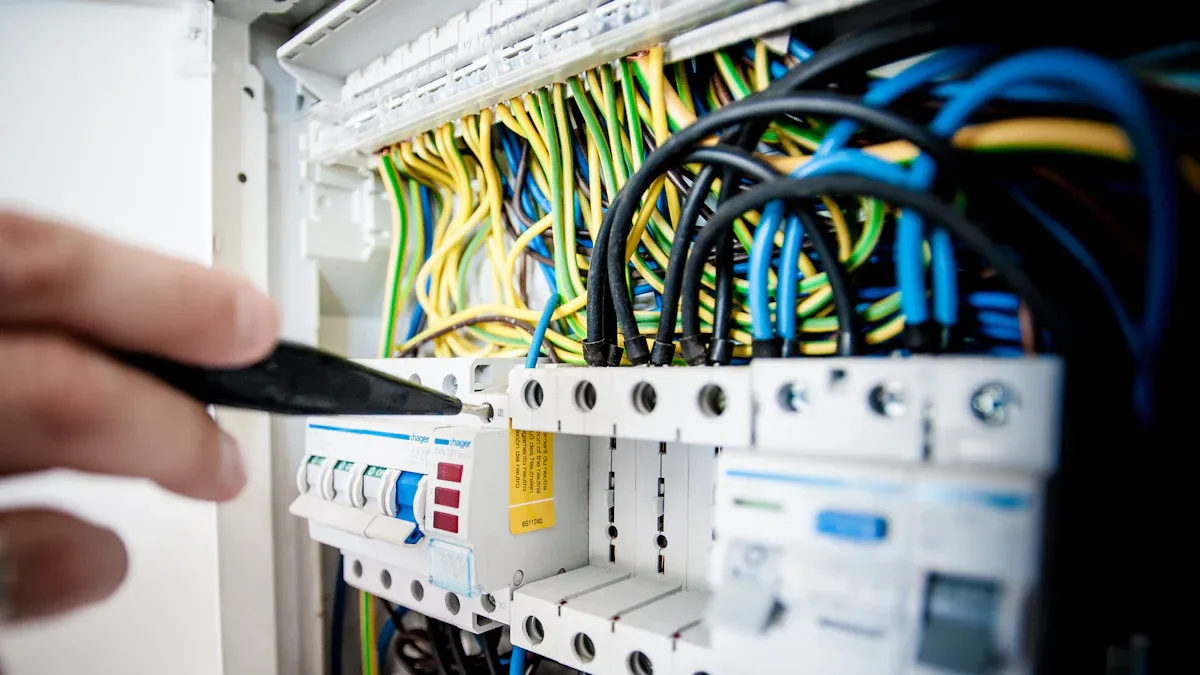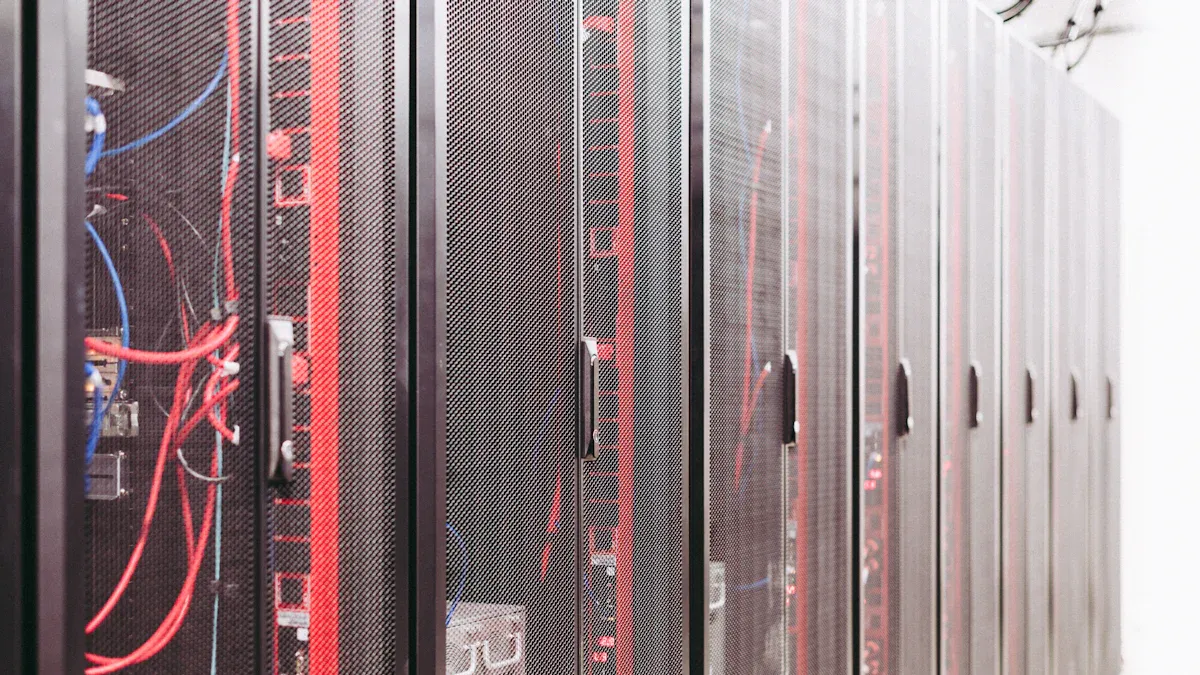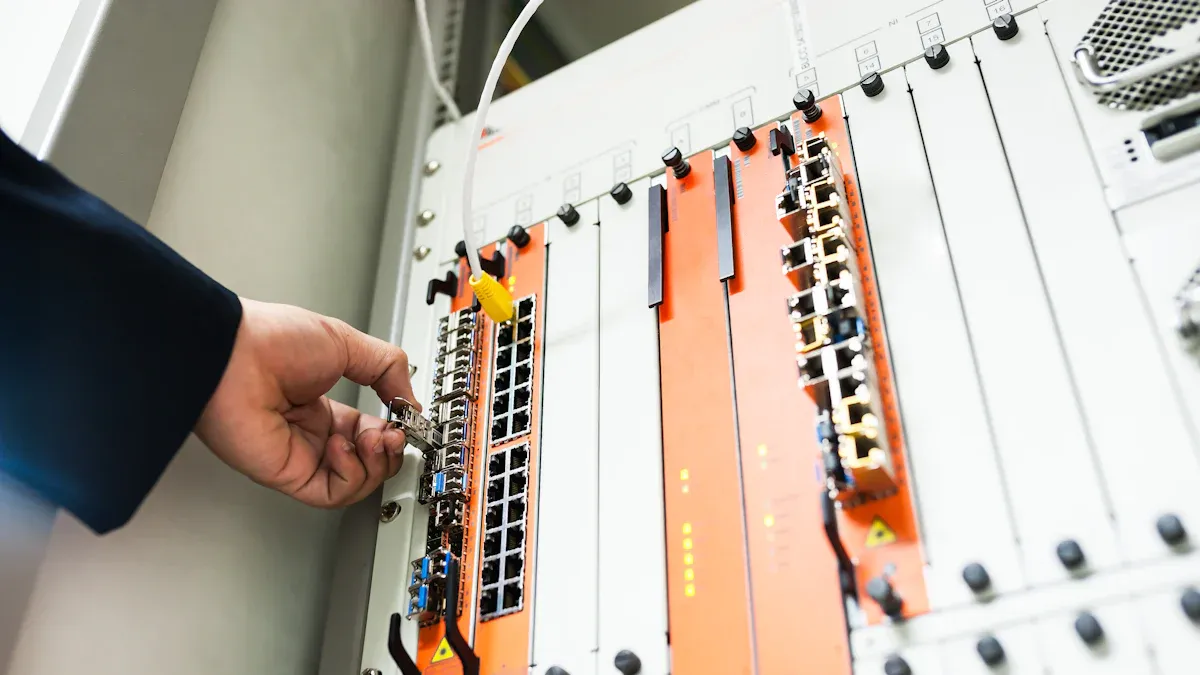ESTEL Tips for Installing Wall Mount Server Cabinets in Tight Spaces

Installing a wall mount server cabinet in a cramped space can feel like solving a tricky puzzle. You’ve got to think about how to fit everything while ensuring the setup stays functional and safe. Compact designs like the VW8 Series, which supports up to 132 lbs, or the VW3 Series with removable panels, can make the job easier. But even with the right tools, proper planning is key to avoid headaches down the road.
Key Takeaways
Pick a strong and easy-to-reach spot for the cabinet. Use a stud finder to find wall studs for safe mounting.
Make sure air can flow around the cabinet to stop it from getting too hot. Add fans if there isn’t enough natural airflow.
Think about power and cable setup ahead of time. Use good cables and keep them neat to help air move and avoid mess.
Preparation Steps for Server Rack Installation
Choosing the Right Installation Location
Finding the appropriate location for your wall mount server cabinet is the first step to a successful installation. You want a spot that’s stable, secure, and easy to access. Use a stud finder to locate wall studs, as these provide the necessary support for the cabinet’s weight. Without this, the cabinet might not stay securely mounted.
Think about height too. Mounting the cabinet at a comfortable level makes maintenance and cable management much easier. Plus, placing it slightly above the floor improves airflow, which is crucial for keeping your equipment cool. Wall-mounted racks work especially well in small spaces like retail stores, classrooms, or branch offices. They save floor space and simplify cable routing, making them ideal for low-density setups.
Ensuring Adequate Ventilation in Tight Spaces
Ventilation is critical when you’re working in compact areas. Without proper airflow, your equipment can overheat, leading to performance issues or even damage. To ensure adequate ventilation, consider the following:
Measurement Type | Value/Recommendation |
|---|---|
Air Change Rate (ACR) | |
Volume Flow Rate (Q) | Based on target occupants (n) |
Effective Opening Areas | Essential for natural ventilation design |
These numbers highlight the importance of maintaining airflow. Make sure the cabinet has enough space around it for air to circulate. If natural ventilation isn’t enough, you might need to install fans or other cooling solutions. Remember, overheating is a common issue in tight spaces, so don’t skip this step.
Planning Power Access and Cable Management
Power and cable management can make or break your setup. High-density environments often require advanced Power Distribution Units (PDUs) to handle power loads effectively. Integrated cable management systems are also a must. They keep cables organized, reduce clutter, and improve airflow.
Here are some tips to optimize your setup:
Use Y power splitter cables to consolidate power for multiple devices. This saves space and reduces costs.
Calculate your power needs carefully. Overloading circuits can lead to safety hazards.
Invest in high-quality cables. They’re more reliable and safer for your equipment.
Proper planning ensures your setup runs smoothly and safely. It also makes future maintenance much easier.
Tools and Equipment Needed for Installation
Having the right tools on hand can save you a lot of time and frustration. Here’s a quick checklist:
Stud finder: Essential for locating wall studs.
Level: Ensures your cabinet is mounted straight.
Drill and screws: For securing the cabinet to the wall.
Measuring tape: Helps you position the cabinet accurately.
Cable ties and management clips: Keeps cables neat and organized.
Some cabinets come with additional features that make installation easier. For example, the 3040 40U cabinet includes EIA support rails for mounting devices and access openings for interface cables. It even has adjustable leveling feet for added stability. Make sure to check your cabinet’s specifications before you start.
Selecting the Best Wall Mount Server Cabinet

Types of Cabinets for Tight Spaces
When working in tight spaces, choosing the right type of cabinet is crucial. Compact cabinets are specifically designed to maximize functionality while minimizing the footprint. These cabinets often feature adjustable and lockable side panels, making them easy to customize for your needs. They also include top and bottom cable entries, which help keep wiring organized and accessible.
For example, some wall-mounted enclosures come with 4 device uprights and shelves, ensuring your equipment stays secure. Additionally, many models have a depth of 24 inches (600mm) and can support up to 187 lbs (85 kg). These features make them ideal for small offices, classrooms, or retail spaces where every inch counts.
Key Features to Consider
Selecting the best cabinet means focusing on features that enhance performance and usability. Here’s a quick checklist to guide you:
Resilient Construction: Look for cabinets made from strong materials like steel or aluminum.
Effective Cooling: Perforated doors or integrated cooling options improve airflow.
Cable Management: Channels and trays keep cables neat and reduce clutter.
Adjustable Mounting Rails: These allow you to fit equipment of varying depths.
Security Features: Lockable doors protect your equipment from unauthorized access.
Portability: Some cabinets include caster racks for easy movement.
These features ensure your cabinet is not only functional but also durable and secure.
Weight Capacity and Size Optimization
Weight capacity is a critical factor when selecting a cabinet. You need a model that can handle the weight of your equipment without compromising stability. For instance, Lenovo Heavy Duty Rack Cabinets can support up to 3500 lbs (1588 kg) in 42U configurations. While this might be overkill for smaller setups, it highlights the importance of choosing a cabinet that matches your needs.
Compact cabinets designed for tight spaces typically support up to 187 lbs (85 kg). They’re made from high-quality materials like 1311 galvanized steel and often include tempered glass panels for added durability. Always check the manufacturer’s specifications to ensure the cabinet can handle your equipment safely.
Step-by-Step Installation Process

Locating Wall Studs and Marking the Wall
Before you install your wall mount server cabinet, you need to find the wall studs. These are the wooden beams behind the drywall that provide the necessary support for your cabinet. Here’s a simple way to do it:
Locate Wall Studs: Use a stud finder to detect the studs. Move the device along the wall until it signals a stud. Mark the spot with a pencil or painter’s tape.
Mark Mounting Points: Measure the distance between the mounting holes on your cabinet. Transfer these measurements to the wall, ensuring they align with the studs.
Double-Check Alignment: Use a level to confirm that your marks are straight. This step ensures your cabinet won’t tilt after installation.
Pro Tip: If you can’t find a stud in the desired location, consider using heavy-duty wall anchors. These provide extra support for your cabinet.
Using Levels for Accurate Mounting
Getting your cabinet perfectly level is crucial for stability and functionality. Uneven mounting can lead to stress on the cabinet and its contents. Follow these tips to ensure accuracy:
Use a high-quality level to check the alignment of your mounting points.
Secure the level on the wall and adjust your marks as needed.
If you’re using advanced tools like the Leica GS18 I, set it up on a tripod to avoid misalignments.
Always follow the manufacturer’s guidelines for mounting configurations.
Note: Misalignment can cause uneven weight distribution, which may compromise the safety of your setup. Take your time with this step to avoid future issues.
Securing the Cabinet and Ensuring Stability
Once your mounting points are marked and aligned, it’s time to secure the cabinet. Here’s how you can do it:
Drill pilot holes into the wall studs at the marked points. This makes it easier to insert screws and reduces the risk of splitting the wood.
Position the cabinet against the wall and align it with the pilot holes.
Use heavy-duty screws to attach the cabinet to the wall. Tighten them securely but avoid over-tightening, which could damage the cabinet or the wall.
Check the stability by gently shaking the cabinet. It should feel solid and not wobble.
Quick Tip: If your cabinet includes adjustable leveling feet, use them to fine-tune its position after securing it to the wall.
Verifying Weight Distribution and Safety
Proper weight distribution is essential for the safety and longevity of your installation. After securing the cabinet, take these steps to verify everything is in order:
Requirement | Description |
|---|---|
Proof Testing | Ensure the cabinet can handle 100% of its rated capacity after installation. |
Weight Alignment | Confirm that the weight is evenly distributed across the mounting points. |
Reminder: Overloading your cabinet can lead to structural failure. Always check the manufacturer’s weight capacity and avoid exceeding it.
By following these steps, you’ll create a stable and secure setup that protects your equipment and ensures smooth operation.
Server Rack Installation Best Practices for Optimization
Efficient Cable Management Techniques
Good cable management can save you time and extend the life of your equipment. Tangled cables make troubleshooting harder and can even lead to overheating. Here’s how you can optimize your server rack setup:
Route cables in a structured way to avoid tangling and interference.
Use marking or color-coding to identify cables quickly during maintenance.
Keep cables organized with trays or clips to improve airflow and reduce hotspots.
Best Practice Guideline | Metric/Benefit |
|---|---|
Structured routing approach | Minimizes interference and tangling |
Organized cables | Promotes better airflow and reduces hotspots |
Marking/color-coding cables | Eases maintenance and troubleshooting |
By following these server rack installation best practices, you’ll reduce troubleshooting time by up to 60% and improve your equipment’s lifespan by over 30%.
Enhancing Cooling and Airflow
Proper ventilation is essential for keeping your server rack setup running smoothly. Without it, your equipment can overheat and fail. Here are some cooling techniques to consider:
Technique | Description | Effectiveness |
|---|---|---|
Airflow Management | Hot-aisle/cold-aisle layouts optimize airflow. | Reduces mixing of hot and cold air. |
Fan Efficiency | High-quality fans improve cooling performance. | Enhances energy efficiency. |
Liquid Cooling | Coolant circulates for precise temperature control. | More efficient than air cooling. |
Combining airflow management with proper ventilation ensures your server rack installation stays cool and energy-efficient.
Space-Saving Tips for Small Areas
Working in tight spaces doesn’t mean sacrificing functionality. You can maximize space with smart strategies:
Use compact cabinets with adjustable shelves to fit your equipment.
Mount racks slightly above the floor to free up space and improve airflow.
Optimize cable routing to reduce clutter and make maintenance easier.
Report Type | Key Features |
|---|---|
Campus Utilization | Overview of People Count, Time Spent, and Room Utilization for the entire campus. |
Building Utilization | Summary of Peak Utilization, People Count, Time Spent, and Room Utilization for each building. |
Floor Utilization | Overview and Heat Map showing Peak Utilization, People Count, and trends for specific floors. |
These tips ensure your server rack setup remains efficient, even in small spaces.
Maintenance and Safety Guidelines
Regular Inspection and Cleaning
Keeping your server cabinet in top shape starts with regular inspections and cleaning. Dust and debris can build up over time, affecting your ventilation system and equipment performance. Create a cleaning schedule and stick to it. Wipe down surfaces, clear out any clutter, and ensure walkways around the cabinet remain free of obstacles.
Spills or hazards should be addressed immediately to prevent accidents. For example, if cables are tangled or blocking access, untangle them and secure them with ties. Proper waste disposal also matters. Segregate and discard waste responsibly to maintain a safe and organized environment. These practices not only prolong the life of your equipment but also ensure clean installs every time.
Tip: Document your cleaning routines in a maintenance log. This helps track progress and ensures compliance with safety standards during audits.
Ensuring Compliance with Safety Standards
Safety standards aren’t just about following rules—they protect you and your equipment during installation and maintenance. Maintenance audits help verify that your practices align with industry benchmarks. For instance, OSHA guidelines focus on workplace safety, while EPA regulations ensure environmental protection.
Here’s a quick look at key compliance areas:
Compliance Area | Importance |
|---|---|
Equipment maintenance schedules | Prevents delays and ensures timely repairs. |
Safety protocols | Reduces risks during equipment installation and maintenance. |
Record-keeping requirements | Provides documentation for audits and legal compliance. |
Training certifications | Ensures installers understand safety practices. |
Fire safety | Minimizes risks associated with overheating or electrical hazards. |
By adhering to these standards, you’ll avoid legal issues and maintain a positive reputation.
Troubleshooting Common Installation Issues
Even with installer-friendly features, problems can arise during setup. Loose screws, misaligned cabinets, or poor cable management can compromise stability and functionality. Start by checking the basics. Are the mounting points secure? Is the weight evenly distributed?
If your cabinet feels unstable, inspect the wall studs or anchors. Adjust the leveling feet if necessary. For ventilation system issues, ensure airflow isn’t blocked by cables or debris. If overheating persists, consider adding fans or upgrading your cooling setup.
Pro Tip: Keep a troubleshooting checklist handy. It speeds up problem-solving and ensures your equipment installation stays safe and efficient.
Installing a wall mount server cabinet in tight spaces doesn’t have to be overwhelming. Focus on these essentials:
Plan ahead for location, ventilation, and power needs.
Choose the right cabinet with features that fit your space.
Maintain regularly to ensure safety and performance.
Apply these tips, and you’ll create a setup that’s safe, efficient, and hassle-free!
FAQ
How do I choose the right server rack for a small space?
Look for compact racks with adjustable shelves and efficient cable management. These features maximize functionality while saving space in tight areas.
Can I install a server rack in network closets?
Yes, but ensure proper ventilation and cooling. Network closets often have limited airflow, so adding fans or optimizing airflow is essential for equipment safety.
What tools are essential for installing a server rack?
You’ll need a stud finder, level, drill, screws, measuring tape, and cable ties. These tools ensure accurate mounting and organized cable management.
See Also
Finding The Right Depth Options For Rackmount Enclosures
Guidelines For Installing ESTEL Cabinets In Tough Environments
Simplifying The Selection Of Rackmount Enclosure Depths
CALL US DIRECTLY
86-13752765943
3A-8, SHUIWAN 1979 SQUARE (PHASE II), NO.111, TAIZI ROAD,SHUIWAN COMMUNITY, ZHAOSHANG STREET, NANSHAN DISTRICT, SHENZHEN, GUANGDONG, CHINA


